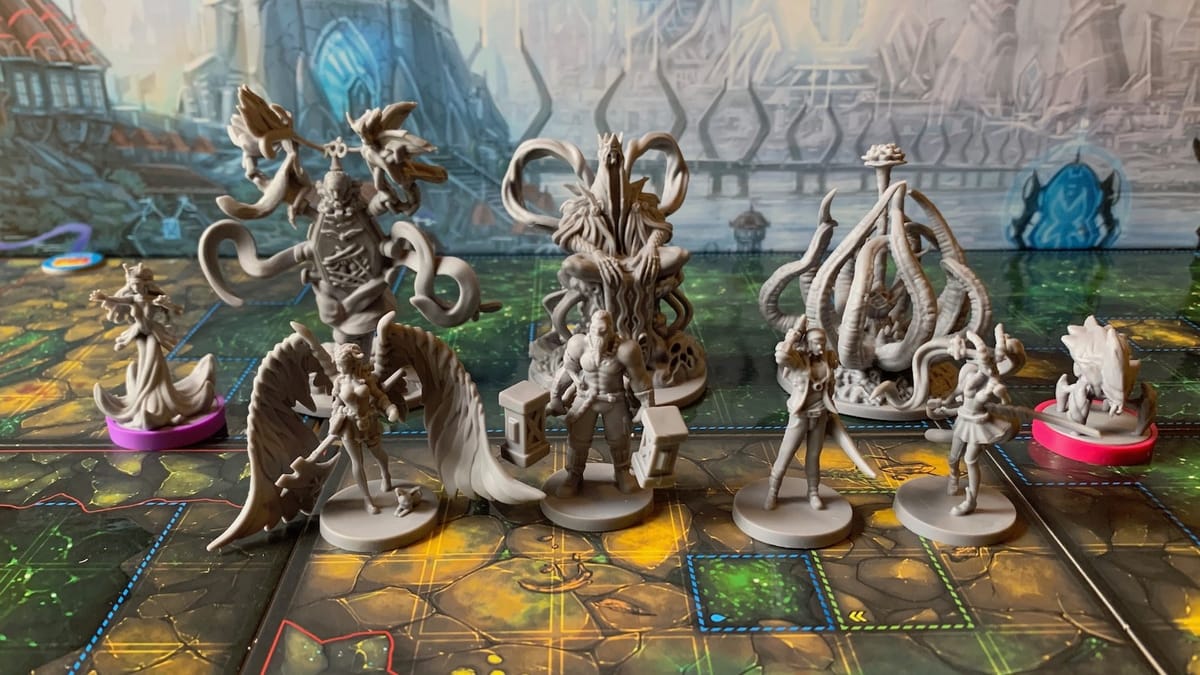
In the world of tabletop games, massive dungeon crawlers have become a favorite of many, and “the bigger the better” seems to be the opinion of the fans and creators. Recent boxes have become gargantuan to house the enormous amount of storytelling and varied options included in the experience. The latest to throw its hat in this ring is Middara by Succubus publishing.
Middara is a HUGE (20 plus pound) 1-4 player game where the players take the roles of 4 hungry new adventurers in the fantastic world of Middara. When learning the game, you get overwhelmed with how big of an undertaking it is. 44 Plastic miniatures take up a good portion of the box, 5 books, many cards, and hundreds of tokens take up the rest. Anyone who backed the Kickstarter will also receive many more minis in a second “Promo Box”. Of the books included, by far the largest is the adventure book for Unintentional Mallum: Act I. This is the biggest book I’ve ever seen included in a game, and will take you through the entire chapter. You also have the option of the much smaller Crawl Book, which sets up single encounters for lighter play. First, you’ll have to read the 71 pages of instruction manual to know how to even approach this game. This game is not for the casual gamer.

When you get in to it, you and ideally 3 other players take the roles of 3 new adventurers: Nightingale Arsen, Remi Moretti, Zeke Jeong, and Rook Lars. These 4 have decided that the life of adventure is for them, and must graduate the MAST tests before being able to venture out on their own seeking glory and treasure. Standing in their way are several challenging maps filled with adversaries, which can be present or hidden depending on the conditions. It’s not easy right off the bat, and the team must learn how to use their individual powers together to get through this test. For the most part early on, win or lose, you continue on. Each round is scored however, and your cumulative score will determine what prizes will be bestowed upon you at graduation, should you pass. This is the only part of the plot I will explain in this review, as like any good storytelling game, the designers have taken careful measures to hide spoilers. You’ll just have to play through to find out what happens to our determined 4.
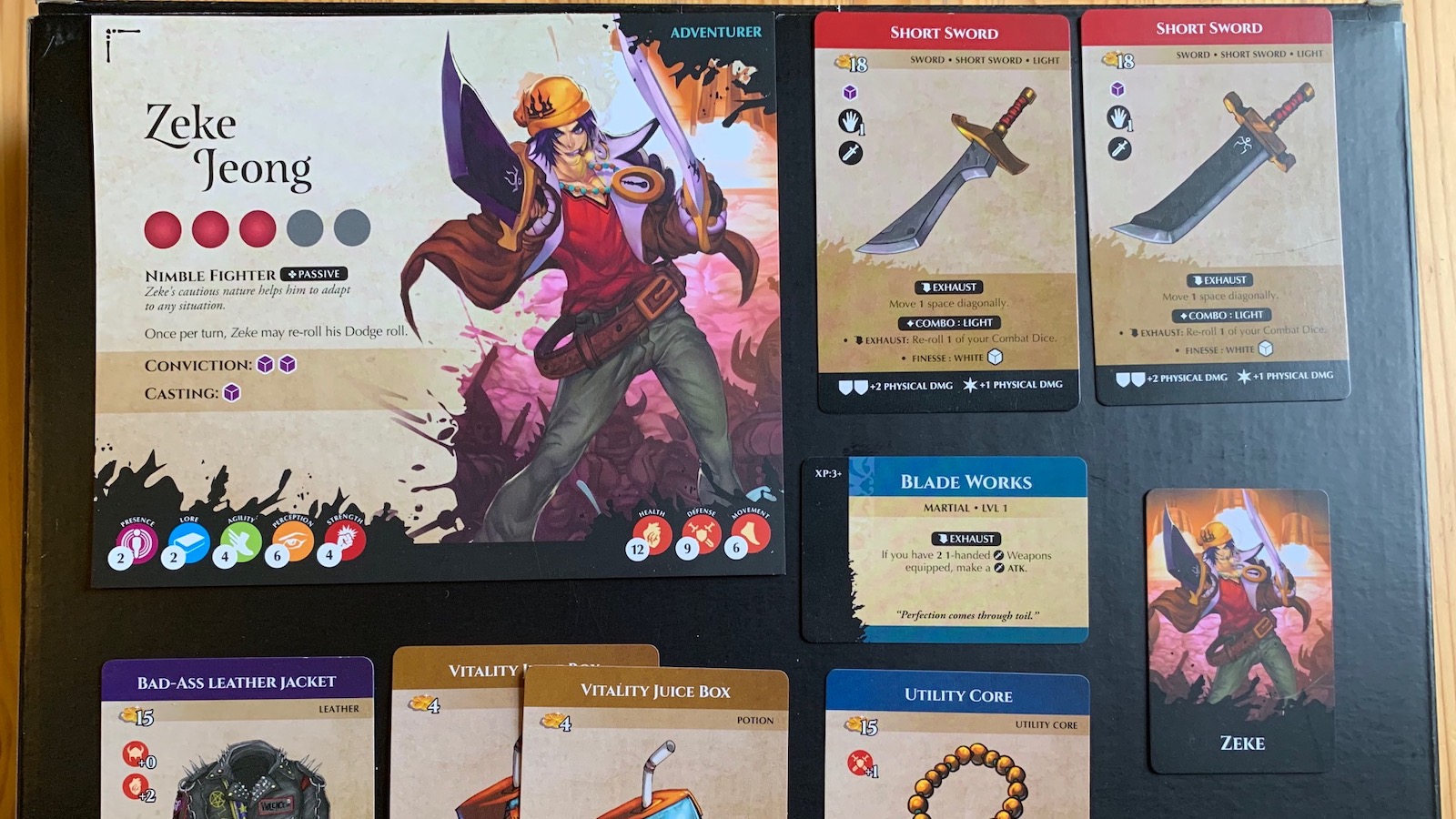
Starting the game, each character has pretty even statistics regarding their stamina, movement, health, and defense. Each has their own natural abilities they bring to the table, and are given cards showing their signature weapons, some light protection, and some one use boost cards. Every ability has a tag telling you when they are available, or what physical action to take to access this power, such as flip the card, “exhaust” the card by turning it 90 degrees showing it has been used already, or discarding it from your possession. The weapon cards have pictures of colored dice on them that correspond with the dice that come with the game. Roll the combat dice shown when making an attack to see how effective your attack was. The player lays all these cards in front of them near their adventurer cards to show all of the statistics and abilities at their disposal during play.
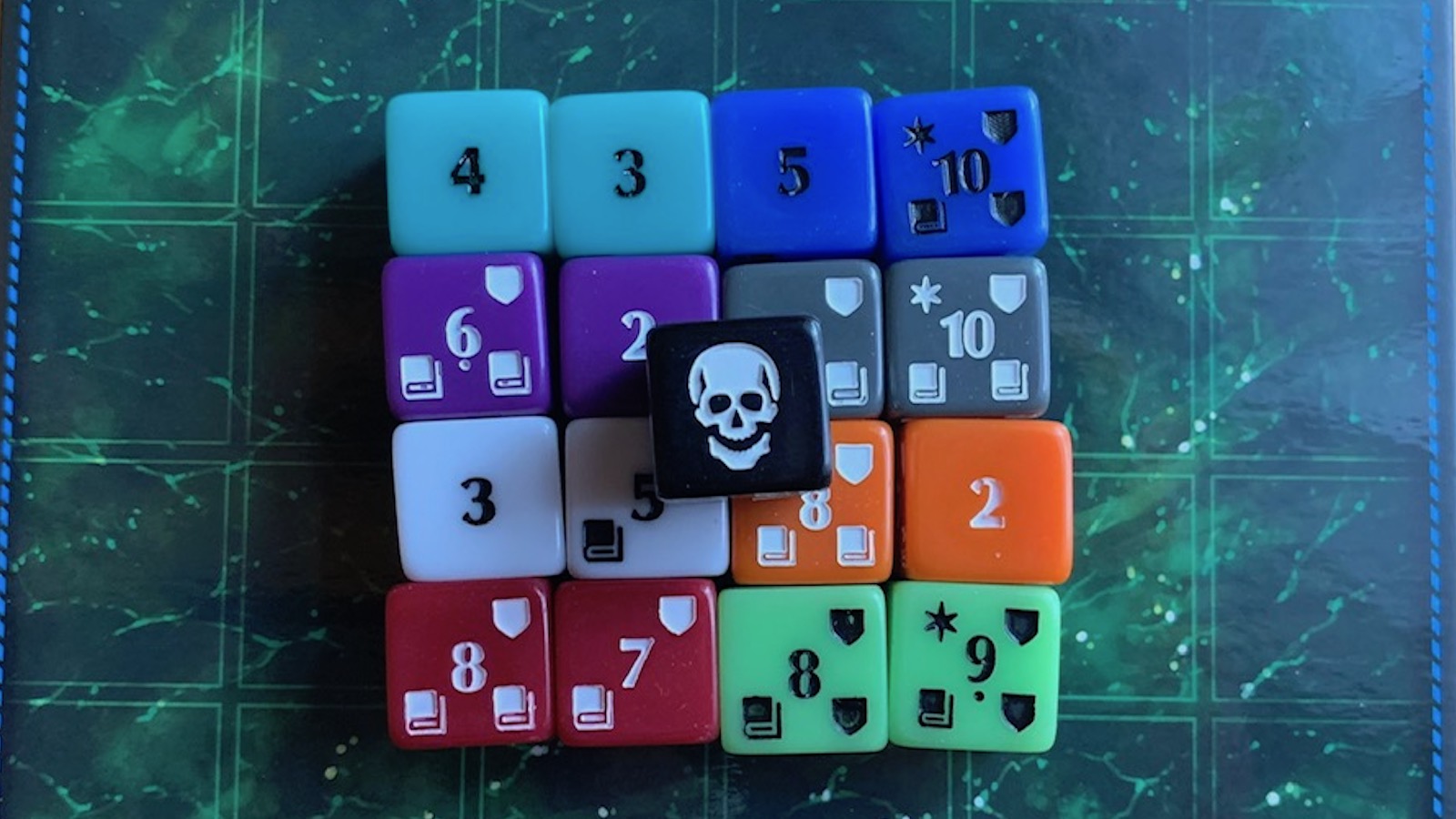 Players consult the Adventure book to read about the story surrounding their current encounter, and how to set up the board. Several of the 36 double sided tiles will be assigned to make up the map for the encounter, and obstacles, such as physical barriers and monsters, will be placed according to the diagram in the book. A clear goal will be set in place, as well as a guide for how to get the most points out of the encounter. The goal may be to simply escape, to kill every bad guy in the room, a combination of those two, or many other end encounter triggers. Regardless, how well you do this will be judged at the end of each encounter. Do a poor enough job, you will have to try again. Typically the grade during the MAST has to do with how many heroes and enemies were defeated, but often a ticking clock is added, taking away points for every round it takes players to succeed.
Players consult the Adventure book to read about the story surrounding their current encounter, and how to set up the board. Several of the 36 double sided tiles will be assigned to make up the map for the encounter, and obstacles, such as physical barriers and monsters, will be placed according to the diagram in the book. A clear goal will be set in place, as well as a guide for how to get the most points out of the encounter. The goal may be to simply escape, to kill every bad guy in the room, a combination of those two, or many other end encounter triggers. Regardless, how well you do this will be judged at the end of each encounter. Do a poor enough job, you will have to try again. Typically the grade during the MAST has to do with how many heroes and enemies were defeated, but often a ticking clock is added, taking away points for every round it takes players to succeed.
Each character currently on the board, be they good or evil, has an “initiative card”. These cards are shuffled face down, and then dealt in a line showing everyone’s initiative, or turn order for the current encounter. Any late-arriving enemies will be put in this line according to who discovered them, and what was rolled on the black dice. An unlucky roll puts the enemy next in turn order, and will probably immediately attack the heroes.
In initiative order, players use their stamina points (a mere 3 per adventurer to start) to take actions on the board. On their turn, these points let them move, attack enemies, and interact with things on the map to best achieve their goal. Try not to use all of your stamina during your turn though, as stamina can then be used to dodge, counter attack, and empower your defense against a spell. A player who has no stamina when attacked will not be able to perform these defensive actions, and may get injured much quicker.
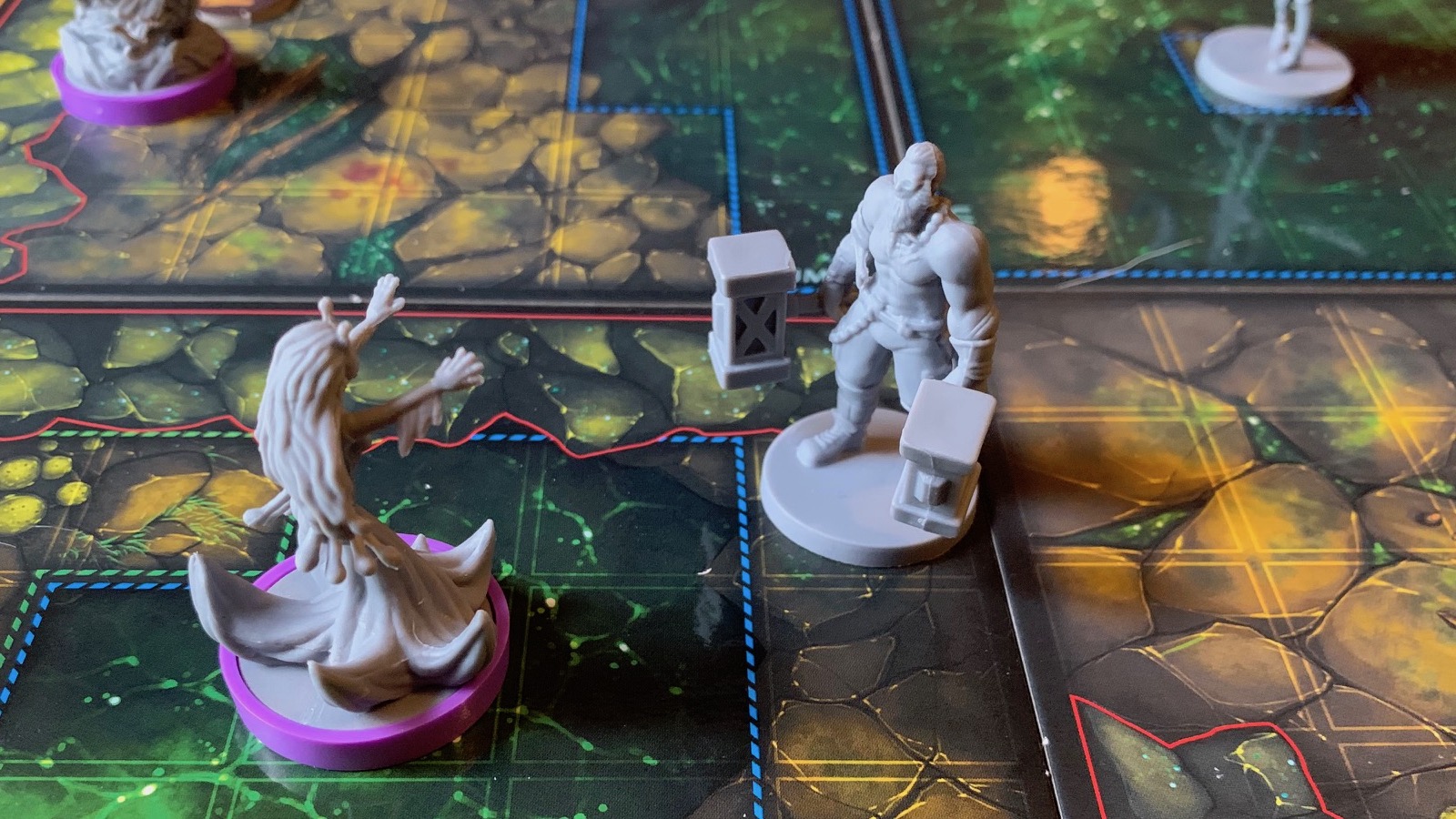
Several of the consequences of player actions of this game are hidden, and players will have to decide whether risks are worth it. For instance, many of the maps have different colored “totems” that activate as soon as an adventurer is in line of sight of the totem. If triggered, you must take the “Red Reveal Decoder” to read the section of the adventure book that tells you if this was a good gamble or not. Some of these throw more bad guys in to the mix, some reveal treasures, or add more room tiles making the room much bigger, and the goal farther away than you originally thought.
At the end of the encounter, whether victorious or defeated, the adventurers will be directed to the next step in the story. Sometimes the next canonical step is the same, but with one stop off for the triumphant to pick up the spoils of victory, but others take the heroes down a different path entirely. Often they are then given an opportunity to buy supplies or abilities and slowly build their character. The weapons one can afford, of course, get increasingly more powerful, and if paired well with others, unlock powers that aren’t available on their own.
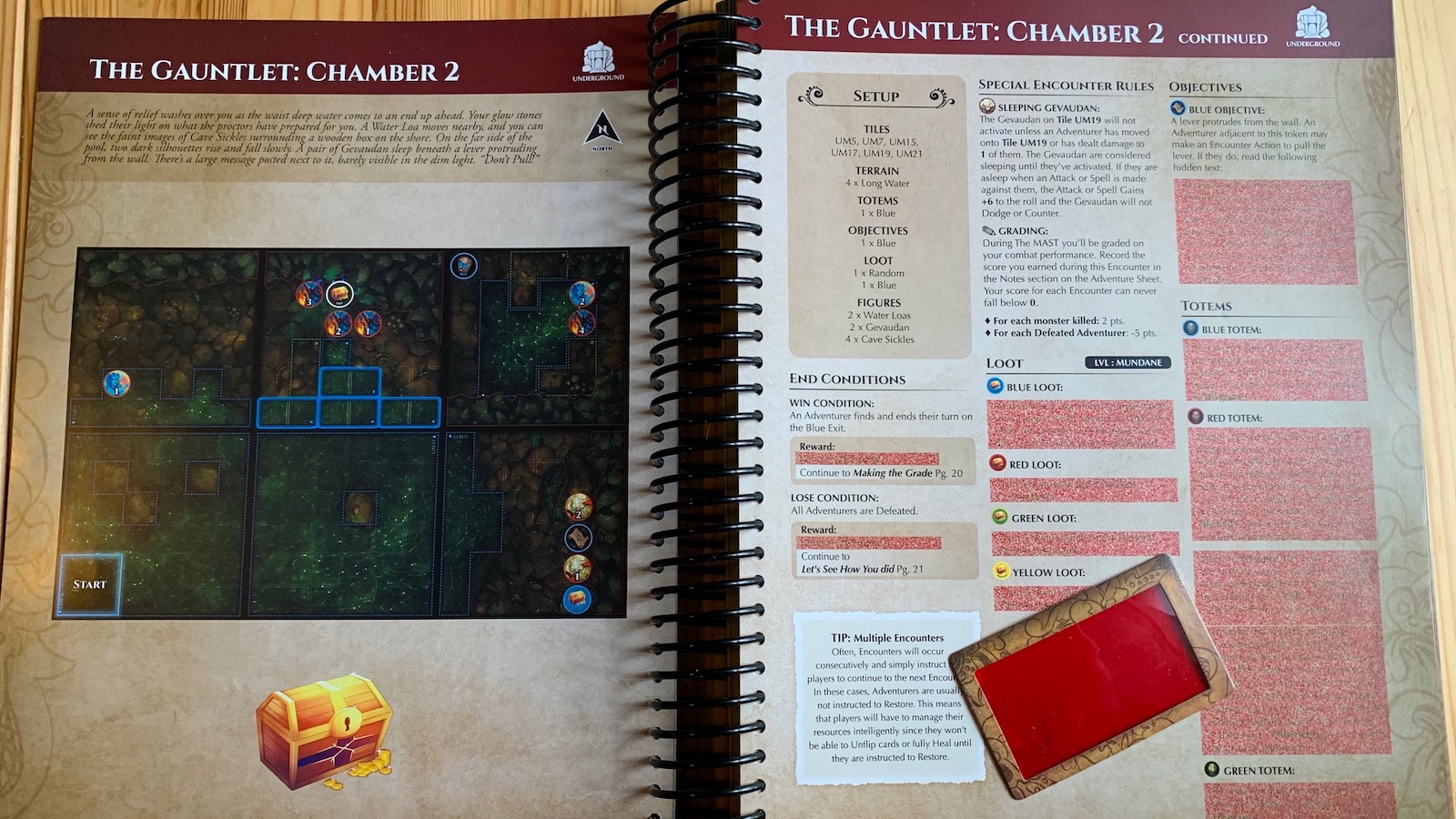 In addition to buying better gear, the players are then given the opportunity to learn how to be a better adventurer. There are 5 disciplines available to learn with 3 levels in each. One can choose to get to the top level of one of these disciplines as quickly as possible, or learn them all at a slower pace to become less powerful, but more well rounded. These powers may also take up precious stamina, but stamina levels are also increase as players successfully make their way through the story. This option allows for a lot of customization for the characters, allowing for players to create any type of character they want, regardless of their strengths or weaknesses at the start.
In addition to buying better gear, the players are then given the opportunity to learn how to be a better adventurer. There are 5 disciplines available to learn with 3 levels in each. One can choose to get to the top level of one of these disciplines as quickly as possible, or learn them all at a slower pace to become less powerful, but more well rounded. These powers may also take up precious stamina, but stamina levels are also increase as players successfully make their way through the story. This option allows for a lot of customization for the characters, allowing for players to create any type of character they want, regardless of their strengths or weaknesses at the start.
What really sets this game apart from others it will inevitably be compared to is the story in the adventure mode. It’s clear that the makers of this game didn’t want to simply create a world in which you get to play and do what you please, they want to tell a tale. Large portions of the Adventure book are purely reading what happens to the characters in between encounters. This results in more reading than ever I’ve encountered in a game before it. To include everyone in the story, most groups will end up reading aloud at the table. If this isn’t anyone’s idea of a good time, there is a companion app that will do it for you.
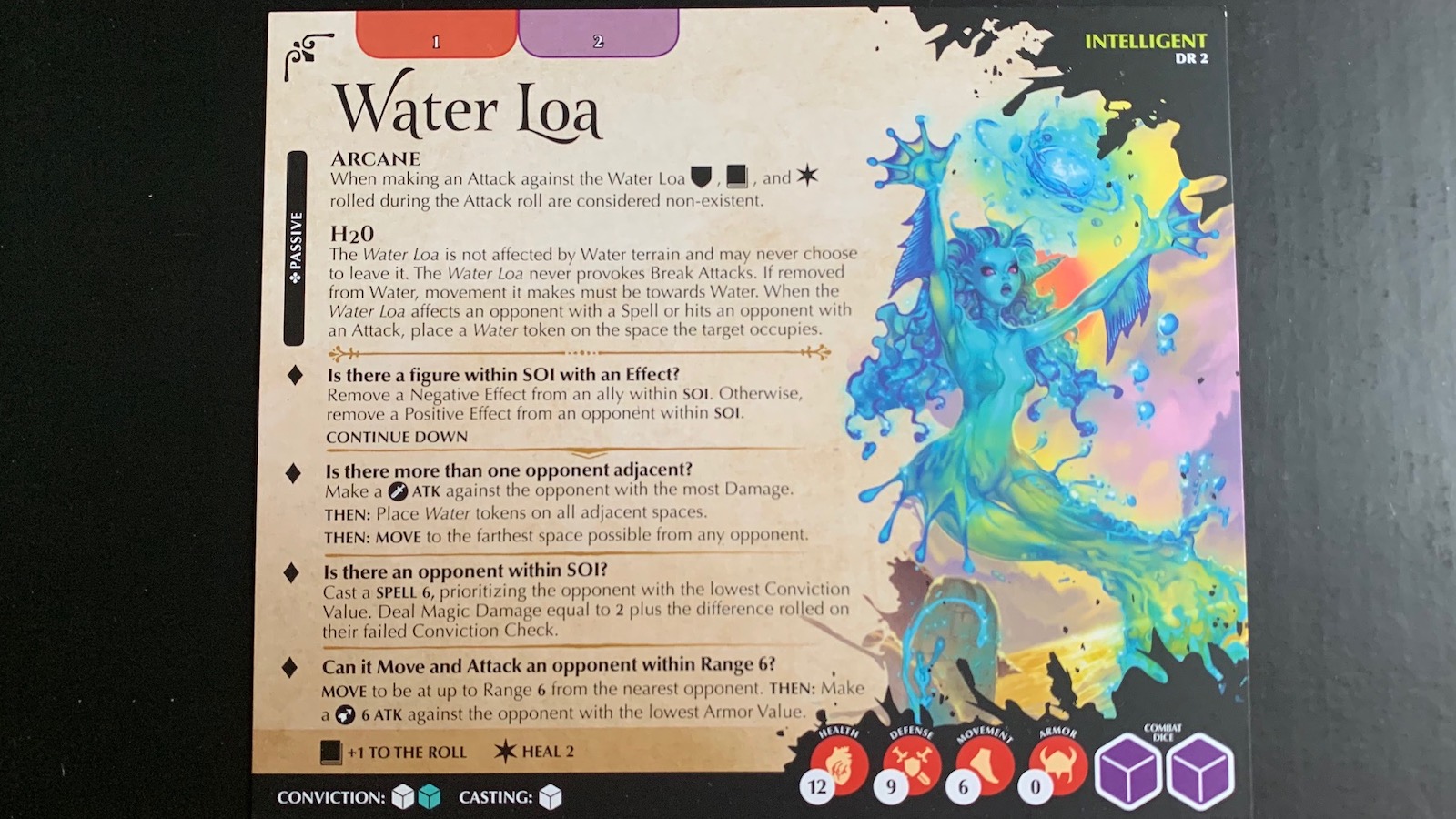 One major way this style of world creation sets itself apart from its peers is sometimes your actions cause the story to end. Sometimes you lose, you die, GAME OVER. The first time it happens there is an amusing note saying “We don’t expect you to start the entire game over, even though our playtesters did…” but some of the future roads end much rougher. I have a feeling no one but the most hard core gamer will start over at that, but the heart breaking pages of what terrible path your actions have lead you down really make your team realize what is at stake in every encounter, and heighten the tension in a really fun way.
One major way this style of world creation sets itself apart from its peers is sometimes your actions cause the story to end. Sometimes you lose, you die, GAME OVER. The first time it happens there is an amusing note saying “We don’t expect you to start the entire game over, even though our playtesters did…” but some of the future roads end much rougher. I have a feeling no one but the most hard core gamer will start over at that, but the heart breaking pages of what terrible path your actions have lead you down really make your team realize what is at stake in every encounter, and heighten the tension in a really fun way.
Kickstarter supporters have been waiting 4 years for this game to show up, so hopes were very high. Art from the books and graphic representations of the minis have been teased the entire time, and people were ready for them. What shows up is enormously impressive in scale, but some of the details fall short. In an age where huge companies like CMON raise over $4 million to make a single game, the standard set for sculpted minis is very high. It wouldn’t be fair to hold a new company to the same standard, but they get pretty close. The minis are many, and really fun, but maybe could have been thought out a bit better once or twice. They run that difficult line of detailed, but not too delicate as to break, but sometimes size is an issue. Remi, one of the main characters, has a huge feathered wingspan, taking up much more than her one small square she is given to stand on at any given time. This makes gameplay a little clumsy and takes away from the experience a little. Small details such as these point to Succubus biting off a bit more than they could chew. The rest of the components, such as the board tiles, and tokens are top notch and beautiful.
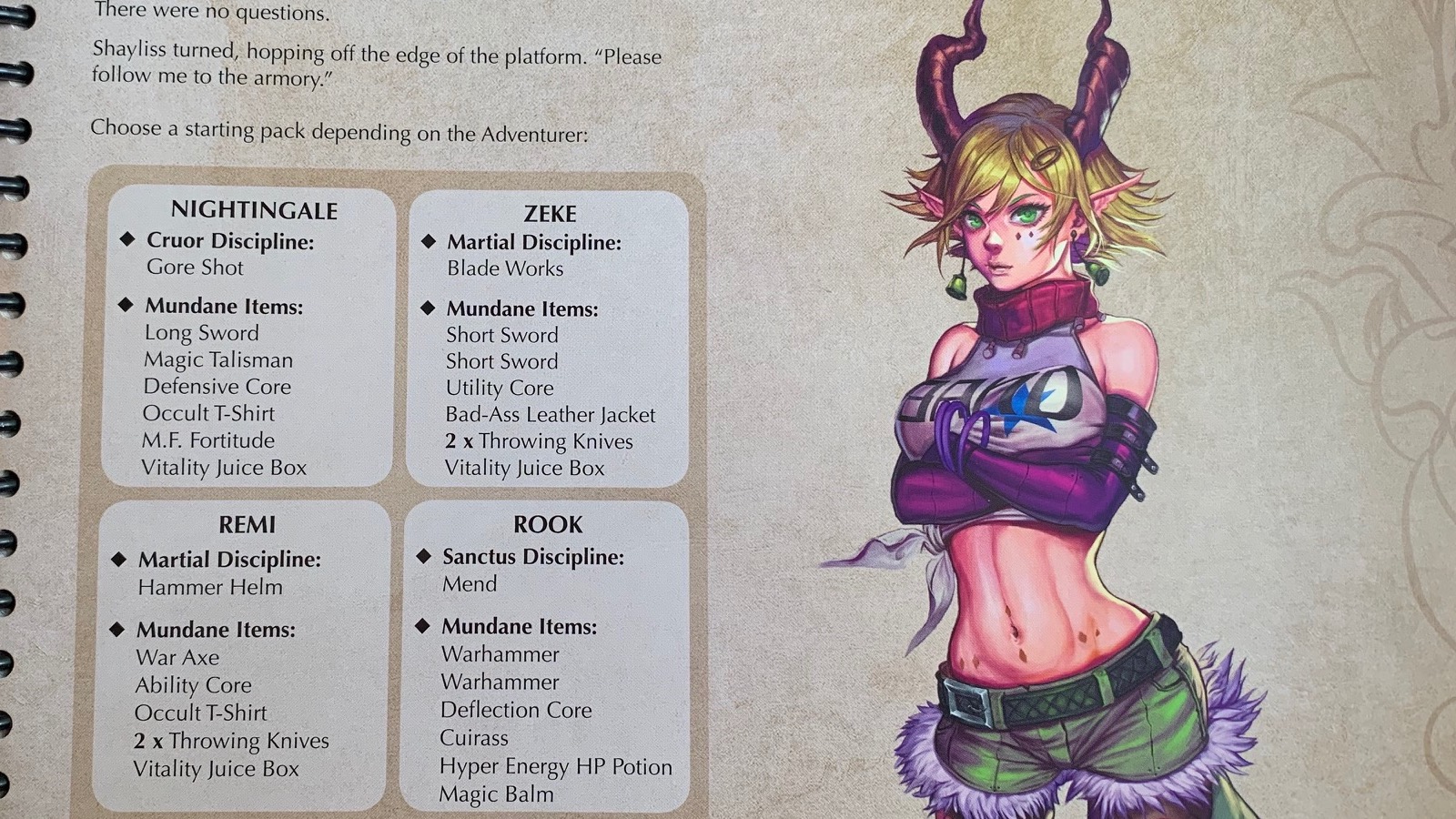
The artists for Middara were hard at work for this game. Every page of every book is covered in it. They style they chose for their characters was the Manga or Anime style. Other than Kingdom Death Monster, most games of this type haven’t delved into this style, and this gives Middara a very distinct look. The problem that can arise with this style is the over-sexualization of the women characters, which doesn’t gel well with the rest of the artwork. This might not be a problem for fans of the genre, but will turn off some players, or perhaps the parents of younger players. This doesn’t seem to enter the story at all, as it’s just present in the artwork. Anyone bothered by this may also be bugged by the large “STAY SEXY” printed in large letters on the side of the promo box.
I love the lofty goal of the huge story written for this game, but it is A LOT of reading. I think many people will be turned off by it, or skip past it. Even listening to someone else read it got tiresome, especially when developing the characters towards the beginning. The story seems to not move along quickly enough, and the writing could use another pass. A lot of the story reads like a Young Adult novel. I’m sure some will be really intrigued by the story involved, but many, like me, will just want to get to the game play. For anyone like me who would be happy with a quick few paragraphs setting the scene, they’ve taken note and have started to provide chapter summaries at here. I feel this was a wise move.
The specific narrative in the story is for the characters mentioned earlier. This means that from the start 4 people have to play, or some people have to play multiple characters. It would be nice for the game to scale better with different player counts, but since they want to tell such a specific story, you have no other option to begin with. Other adventurers can be brought in later and switched out, but still the four character count will remain.
Overall, I enjoyed this game. The gameplay reminded me of Descent or Imperial Assault, and a lot of the world building reminded me of Gloomhaven. The problem is, those games have all but perfected their craft. Compared to those giants, Succubus’ green horns start to show. I honestly think they could tighten up this game and make it the favorite for a lot of people, but I may leave it here and go back to those other games I never finished. I look forward to see how they’ve learned from this experience with their next release.
Middara Unintentional Malum: Act 1
Good
Middara is a huge first effort that is a pretty good dungeon crawler, but the quality of the miniatures, and the sheer amount of reading may turn off fans of the genre. The miniature design is almost great, but backers that waited 4 years for this game will notice its flaws. A great maiden voyage, but improvements are needed.
Pros
- Huge story to play through, with more chapters to come
- Good, challenging game play with great character building
- Lots of content and ways to play
Cons
- Doesn’t scale well for different player counts
- Story can get long winded, and not for everyone.
- Character design may be too sexual for some
